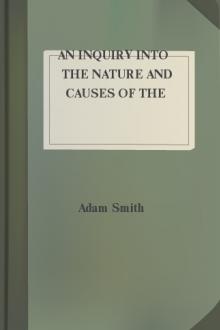The Wealth of Nations by Adam Smith (the best motivational books .TXT) 📕

Description
The Wealth of Nations is economist Adam Smith’s magnum opus and the foundational text of what today we call classical economics. Its publication ushered in a new era of thinking and discussion about how economies function, a sea change away from the older, increasingly-irrelevant mercantilist and physiocratic views of economics towards a new practical application of economics for the birth of the industrial era. Its scope is vast, touching on concepts like free markets, supply and demand, division of labor, war, and public debt. Its fundamental message is that the wealth of a nation is measured not by the gold in the monarch’s treasury, but by its national income, which in turn is produced by labor, land, and capital.
Some ten years in the writing, The Wealth of Nations is the product of almost two decades of notes, study, and discussion. It was released to glowing praise, selling out its first print run in just six months and going through five subsequent editions and countless reprintings in Smith’s lifetime. It began inspiring legislators almost immediately and continued to do so well into the 1800s, and influenced thinkers ranging from Alexander Hamilton to Karl Marx.
Today, it is the second-most-cited book in the social sciences that was published before 1950, and its legacy as a foundational text places it in the stratosphere of civilization-changing books like Principia Mathematica and The Origin of Species.
Read free book «The Wealth of Nations by Adam Smith (the best motivational books .TXT) 📕» - read online or download for free at americanlibrarybooks.com
- Author: Adam Smith
Read book online «The Wealth of Nations by Adam Smith (the best motivational books .TXT) 📕». Author - Adam Smith
Ed. 1 reads “degraded.” ↩
See above, here. ↩
Lowndes, Essay, p. 88. ↩
Lowndes’s Essay on the Silver Coin, p. 68. —Smith
This note appears first in ed. 2. —Cannan ↩
Above, here. ↩
The meaning is “given a certain area and intensity of cultivation, the bounty will raise the price of corn.” ↩
Ed. 1 does not contain “upon the principles of a system which I shall explain hereafter.” The reference is presumably to here through here. ↩
Ed. 1 reads here “a notion which I shall examine hereafter.” ↩
Doubtless by a misprint ed. 5 omits “first.” The term is used again at the end of the paragraph and also here through here. ↩
See the table at the end of the chapter; ¹⁹⁄₃₂ is a mistake for ⁹⁄₃₂. ↩
The 25 percent is erroneously reckoned on the £2 0s. 6¹⁹⁄₃₂d. instead of on the £2 11s. old. The fall of price is really less than 21 percent. ↩
The date is taken from the heading of Scheme D in Davenant, Essay Upon the Probable Means of Making a People Gainers in the Balance of Trade, 1699, p. 22, Works, ed. Whitworth, 1771, vol. ii, p. 184. Cp. Natural and Political Observations and Conclusions Upon the State and Condition of England, by Gregory King, Esq., Lancaster, H., in George Chalmers’ Estimate of the Comparative Strength of Great Britain, 1802, p. 429; in Davenant, Balance of Trade, pp. 71, 72, Works, vol. ii, p. 217. Davenant says “this value is what the same is worth upon the spot where the corn grew; but this value is increased by the carriage to the place where it is at last spent, at least ¼ part more.” ↩
Ed. 1 does not contain this parenthesis. ↩
See this note. ↩
Ed. 5, doubtless by a misprint, omits “even.” ↩
Below, here through here. ↩
The references to Dupré de St. Maur and the Essay (see above, p. 181, note), as well as the whole argument of the paragraph, are from Messance, Recherches sur la population des généralités d’Auvergne, etc., p. 281. Messance’s quotations are from Dupré’s Essai sur les Monnoies, 1746, p. 68, and Herbert’s Essai sur la police générale des grains, 1755, pp. ix, 77, 189; cp. below, here. ↩
Above, here through here. ↩
Examined below, here. ↩
See the table at the end of the chapter. ↩
This figure is obtained, as recommended by Charles Smith (Tracts on the Corn Trade, 1766, p. 104), by deducting one-ninth for the greater size of the Windsor measure and one-ninth from the remainder for the difference between best and middling wheat. ↩
“Tract 3rd,” referred to a few lines farther on, only gives the quantities of each kind of grain exported in each year (here through here), so that if the figures in the text are taken from it they must have been obtained by somewhat laborious arithmetical operations. The particulars are as follows:—
Exported Bounty payable Qr. Bush. Wheat 3,784,524 1 £946,131 0 7½ Rye 765,056 6 133,884 18 7½ Barley, malt and oats 3,479,575 2 434,946 18 1½ 8,029,156 1 £1,514,962 17 4½↩
“Years” is apparently a mistake for “months.” “There is such a superabundance of corn that incredible quantities have been lately exported. I should be afraid to mention what quantities have been exported if it did not appear upon our customhouse books; but from them it appears that lately there was in three months’ time above £220,000 paid for bounties upon corn exported.” —Parliamentary History (Hansard), vol. xiv, p. 589 ↩
See Tracts on the Corn Trade; Tract 3d. —Smith
This note appears first in ed. 2. The exports for 1750 are given in C. Smith, op. cit., p. 111, as 947,602 qr. 1 bush. of wheat, 99,049 qr. 3 bush. of rye, and 559,538 qr. 5 bush. of barley, malt and oats. The bounty on these quantities would be £324,176 10s. —Cannan ↩
Above, here. ↩
Ed. 1, perhaps correctly, reads “quantity.” ↩
Ed. 1 reads “fifth.” ↩
Above, here. ↩
Ed. 1 reads “fell to a third and then to a fifth, at which rate it still continues.” ↩
Solorzano, vol. ii. —Smith
Solorzano-Pereira, De Indiarum Jure, Madrid, 1777, lib. v, cap. i, §§ 22, 23; vol. ii, p. 883, col. 2. Ed. 1 does not contain the note. —Cannan ↩
Ed. 1 reads “one and thirty years before 1535.” The date 1545 is given in Solorzano, De Indiarum Jure, Madrid, 1777, vol. ii, p. 882, col. 2. ↩
Ed. 1 reads “In the course of a century.” ↩
Ed. 1 reads “A hundred years.” ↩
Ed. 1 reads “lower” instead of “reduce,” and does not contain “not only to one-tenth, as in 1736, but to one-twentieth.” See this note. ↩
Below, here. Raynal, Histoire philosophique, Amsterdam ed. 1773, tom. iii, pp. 113, 116, takes the same view of the Peruvians. ↩
Below, here through here passim. ↩
Voyage to the South





Comments (0)